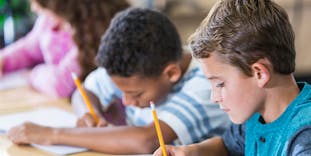How to Pass the NWEA MAP Assessment in 2025
Updated January 29, 2024
- A List of NWEA MAP Tests available for Practice in 2025
- What Is an NWEA MAP Assessment?
- NWEA MAP Assessment Grades in Detail
empty
empty
empty
empty
empty
empty
empty
empty
empty
- NWEA MAP Practice Test – Free Sample Questions for 2025
empty
empty
empty
empty
- Why Should You Take the NWEA MAP Assessment?
empty
empty
empty
empty
- How to Pass an NWEA MAP Assessment in 2025
- How to Prepare for NWEA MAP Test
- Mistakes to Avoid Preparing for the NWEA MAP Test
- Frequently Asked Questions
- Final Thoughts
A List of NWEA MAP Tests available for Practice in 2025
- NWEA MAP Kindergarten
- NWEA MAP 2nd Grade
- NWEA MAP 3rd Grade
- NWEA MAP 4th Grade
- NWEA MAP 5th Grade
- NWEA MAP 6th Grade
- NWEA MAP 7th Grade
- NWEA MAP 8th Grade
- NWEA MAP 9th to 12th Grade
What Is an NWEA MAP Assessment?
The Northwest Evaluation Association Measures of Academic Progress test, or NWEA MAP test, is an achievement assessment that measures student growth and student progress throughout the school year and all the way to high school.
Unlike other forms of academic assessment, the NWEA MAP is a multiple-choice test, which adapts to participants' responses to create a more tailored and personalized experience.
Depending on the needs of the students, teachers can choose to administer the test in a variety of subjects, including reading, math, language usage and science.
There is no requirement for students to take all of the possible sections, and schools have the option of using full-length assessments or shorter 'survey' assessments.
Unlike other assessments, the NWEA MAP tests can accurately identify not only where a student is in relation to age-related expectations but how far ahead of their peers they might be.
Practice Map Test with Test Prep Online
NWEA MAP Assessment Grades in Detail
NWEA MAP Kindergarten
- Assesses the knowledge of 5 to 6-year-old children (grade K) in math and reading
- Due to the reading level of the test-takers, all questions are recorded and most questions are picture-based
- 40+ questions per test
NWEA MAP 2nd Grade
- Taken by children in the 2nd grade to help teachers and parents assess progress and needs.
- The NWEA MAP K-2 is a recorded version of the 2nd grade test for students who cannot yet read.
- The NWEA MAP 2-5 is a written test for students who can read.
- Measures math, language usage, reading comprehension and science
You can find more info on the NWEA test tailored for 2nd grade in our article here.
NWEA MAP 3rd Grade
- Taken by children in the 3rd grade to help teachers and parents assess progress and needs.
- This MAP assessment measures math, language usage and reading skills
You can find more info on the NWEA test tailored for 3rd grade in our dedicated article.
NWEA MAP 4th Grade
- Taken by children in the 4th grade to help teachers and parents assess progress and needs.
- This MAP assessment evaluates students' proficiency in math, language usage, and reading abilities.
You can find more info on the NWEA test tailored for 4th grade in our article here.
NWEA MAP 5th Grade
- Taken by children in the 5th grade to help teachers and parents assess progress and needs.
- This NWEA MAP assessment evaluates students' proficiency in math, language usage, and reading abilities.
You can find more info on the NWEA test tailored for 5th grade in our article here.
NWEA MAP 6th Grade
- Taken by children in the 6th grade to help teachers and parents assess progress and needs.
- This NWEA MAP assessment evaluates students' proficiency in math, language usage, and reading abilities.
You can find more info on the NWEA test tailored for 6th grade in our article here.
NWEA MAP 7th Grade
- Taken by children in the 7th grade to help teachers and parents assess progress and needs.
- This NWEA MAP assessment evaluates students' proficiency in math, language usage, and reading abilities.
You can find more info on the NWEA test tailored for 7th grade in our article here.
NWEA MAP 8th Grade
- Taken by children in the 8th grade to help teachers and parents assess progress and needs.
- This NWEA MAP assessment evaluates students' proficiency in math, language usage, reading abilities and sometimes science MAP test.
You can find more info on the NWEA test tailored for 8th grade in our article here.
The 9th to 12th Grade NWEA MAP Assessments
These tests for the later grade levels assess a student's knowledge and skills in reading, language usage and mathematics.
The 12th grade MAP NWEA test is designed to measure a student's mastery of more advanced content and skills than the earlier grade levels and is often used by high schools and districts to assess student readiness for college and career.
The results of the NWEA MAP test can help teachers and counselors guide students toward appropriate courses and post-secondary opportunities, as well as identify areas of strength and weakness to inform targeted instruction and support.
Practice the 9th to 12th Grade MAP with Test Prep Online
NWEA MAP Practice Test – Free Sample Questions for 2025
Students taking the NWEA test will be presented with a series of computer-based MAP questions.
These are generally in a multiple-choice format, although some will require students to fill in a blank space with their answers and others may be drag-and-drop style questions.
The NWEA MAP assessment is tailored to the age of the child taking it, with tests getting harder as children get older.
This means that young children who are unable to read may have the questions read to them, while older children will have more complex questions related to their age-related expectation of academic achievement.
Generally, there are four types of NWEA MAP questions which are asked:
- Reading
- Math
- Language Usage
- Science
MAP NWEA practice tests are essential tools for students looking to excel in their academic performance.
These MAP practice tests provide valuable resources to enhance their skills.
The MAP testing practice prepares you for the actual MAP assessments.
This would include NWEA math practice tests and MAP test reading practice.
Whether it's MAP math or reading, students can utilize these practice tests to gain familiarity with the format, question types and time constraints of the exams.
By engaging in MAP test practice, students can identify their strengths and weaknesses, allowing them to focus their efforts on areas that require improvement.
Moreover, educators often recommend MAP prep materials to their students as they align closely with the curriculum, ensuring comprehensive coverage of key concepts.
With MAP recommended practice, students can boost their confidence and achieve optimal results in their MAP assessments.
NWEA MAP Test Reading
Children who take the reading section of the NWEA MAP test will be required to show their understanding of the written word as well as their ability to analyze passages.
The level of skill required will depend heavily on the age of the child and the level of understanding they should have.
The reading test will have MAP questions relating to grammatical principles as well as questions asking students to explain the meaning of what they have read.
For young children, this can involve looking at their understanding of phonics. For older children, this may include reading comprehension style questions which consider what a text means.
Select the onomatopoeia in the sentence below:
The cat purred as the little girl stroked it.
NWEA MAP Math Test
The type of question found in the math section of the MAP assessment will vary considerably depending on the age of the child.
Kindergarten, first and second grade children might be expected to only be able to answer problem-solving and arithmetic questions.
Older students will also be asked algebra, graph and geometry related MAP questions.
Select the prime number:
a) 1
b) 5
c) 14
d) 26
If you want 12-month access to all the practice resources for this test, our partner TestPrep-Online.com offers a Family Membership.
Family Membership gives you access to all the TestPrep-Online resources for the next 12 months. You will also get two separate accounts, which can be very helpful if you have two children preparing for their tests.
Get a Family Membership with 12-month access
NWEA MAP Language Usage Test
The language section of the NWEA MAP is designed to assess a student's spelling and vocabulary skills.
As well as a selection of multiple-choice MAP questions which look at spelling and grammar skills, children will be required to complete an essay.
The length and complexity of this will vary depending on the age of the child.
Which of these sentences requires a question mark?
a) The boys didn’t get tired when they played football
b) The boys played football all day
c) How can the boys play football all day without getting tired
d) She didn’t know how they boys played football all day without getting tired
NWEA MAP Science Test
This is the least commonly used section of the MAP assessment and not all students will take it.
The science section will cover topics such as:
- Earth and space sciences
- Physical sciences
- Life science
Which is the smallest part of an atom?
a) Proton
b) Neutron
c) Electron
Why Should You Take the NWEA MAP Assessment?
It is always a good idea to keep an eye on your children's progress.
Not only does this help to build confidence when they know that they are doing well; however, it can also mean that early intervention is possible if they begin to struggle.
Not only that, but if your child is performing above their peers, then regular assessments can offer the opportunity to further their knowledge by gaining entry to gifted and talented programs.
Gifted and Talented Programs
Gifted and talented programs are designed to help the brightest children excel and offer the opportunity to learn things that they wouldn't be able to as part of their normal education.
Entries into these programs are often subject to strict requirements.
Taking assessments such as the NWEA MAP can offer students the opportunity to showcase their abilities and gain a place on a gifted and talented program.
Early Intervention Opportunities
If your child is struggling at school, then it is important to put interventions into place as quickly as possible.
The exact nature of these interventions can vary depending on the severity of the need.
Taking an NWEA MAP assessment can help to identify any areas which a child is finding particularly challenging.
This way, it is easier to put the appropriate interventions into place to help a child reach their potential.
To Gain an Accurate Understanding of Progress
Regularly undertaking assessments is a good way of ensuring that students are making progress.
The most recent MAP test scores can be compared to past student scores to see how a child has progressed and offers an opportunity to quickly identify if a child is struggling to progress as they should.
To Gain an Accurate Projection of Future Performance
By comparing a range of MAP testing results and looking at how a child has progressed, it is possible to predict their future performance.
Practice Map Test with Test Prep Online

How to Pass an NWEA MAP Assessment in 2025
While the NWEA MAP assessment is designed to measure a child's academic abilities, it can seem a little daunting if they are not used to formal assessments.
There are several things that can be done to help build confidence and familiarity to help your child achieve the best possible results.
Step 1. Source & Use NWEA MAP Reading Test Practice
A key part of the NWEA MAP assessment involves evaluating a child's reading comprehension and language skills.
One of the best ways of improving these skills is to practice comprehension questions.
Building familiarity with this type of question can help a child to build confidence and understand how best to answer them.
Step 2. Read a Variety of Materials With Your Child
It is important for children to be exposed to a wide variety of reading materials.
Reading a mixture of fiction and non-fiction materials will widen the scope of a child's understanding and increase the learning opportunities.
If your child is particularly interested in a specific subject, such as animals, space or machines, then it is a good idea to embrace this and find books on these subjects.
Reading about topics that interest children help to build their interest and increases the opportunity for questions to be asked.
Step 3. Use Writing NWEA MAP Practice Tests
The NWEA MAP assessment includes an essay question.
To answer this, children must be able to write in a legible way, with accurate spelling and punctuation.
While encouraging children to read will increase their vocabulary, it is also important to practice writing so that they can put their enhanced vocabulary to good use.
Consider writing notes to each other or family members, sending postcards when you go on vacation and encouraging children to write birthday and Christmas cards for their friends. Or you can work on MAP practice tests that are specifically tailored to your child’s grade.
Every time your children practice their writing skills, they will build confidence, encourage correct spelling and increase their understanding of how best to use punctuation.
Step 4. Play Number Games
There are a variety of ways to plan number games with your child.
You could practice simple additions, subtraction and multiplication questions while on a long car journey to improve mental arithmetic skills.
Alternatively, there are several websites and apps can be used to practice a broad range of math skills or even get specific NWEA math practice tests.
Many of these are designed as games to make them fun for children to do.
Step 5. Encourage Children to Ask Questions
Children are naturally inquisitive, and one of the best ways for them to learn is by asking questions.
Encourage your children to ask questions about the world around them. If you are unsure of the answer, work together to find it.
This will encourage them to learn how to answer questions themselves and also shows them that it's alright not necessarily to know everything.
Step 6. Spend Time in Nature and Make Observations of the World Around You
Many children learn best with a hands-on approach. Spending time outdoors can be a great way of helping children to increase their learning and understanding of the world around them.
This can be in your backyard, a local park or any other outside space.
Time outside can help foster children's curiosity and independence and encourage them to answer questions about the things they observe.
Step 7. Take MAP NWEA Practice Tests
One of the best ways for children to build confidence with tests is to practice them.
There are many ways of practicing questions for the NWEA MAP assessment, but regular practice will help them to familiarise themselves with the style of questions they are likely to find and understand how they should be answered.
Step 8. Ensure Your Child Is Well Rested Before the NWEA MAP Assessment
It is important to ensure that your child has a good night's sleep ahead of the NWEA MAP assessment.
Several studies have shown that a lack of sleep negatively affects cognitive performance when it comes to taking tests.
Being well-rested means that your child will be able to focus and concentrate and will help your child to perform to the best of their ability.
Practice NWEA MAP Test with Test Prep Online
How to Prepare for NWEA MAP Test
Preparing for the MAP (Measure of Academic Progress) test can help your child feel more confident and perform well on the assessment.
Here are some tips to help your child prepare for the MAP test:
-
Understand the Test Format: Familiarize yourself and your child with the structure and format of the MAP test.
-
Review the Content: Review the content covered in each subject area, such as math concepts, reading comprehension strategies and grammar rules.
-
Use MAP Test Preparation Resources: Utilize MAP test preparation resources provided by a school or district.
-
Practice with Sample Questions: Seek out sample questions and practice materials available for the MAP test.
-
Analyze Your Performance: After practicing with sample questions or taking practice tests, review your child's answers and identify areas of strength and weakness.
-
Create a Study Schedule: Develop a study schedule that allows them to allocate dedicated time for MAP test preparation.
-
Seek Help and Clarification: If you encounter difficult concepts or questions during preparation, don't hesitate to seek help from teachers, tutors or classmates.
-
Take Care of Yourself: Get sufficient sleep, eat nutritious meals, and engage in regular physical activity.
Mistakes to Avoid Preparing for the NWEA MAP Test
When preparing for the NWEA MAP test, it's important to be aware of common mistakes that students might make during their preparation.
Here are some mistakes to avoid when preparing for the NWEA MAP test:
-
Neglecting to Understand the Test Format: One common mistake is not taking the time to thoroughly understand the format of the MAP test.
-
Focusing Exclusively on Test-Taking Strategies: While test-taking strategies are important, it's equally crucial to focus on building foundational knowledge and skills.
-
Not Reviewing the Content Covered: The MAP test is designed to assess a student's proficiency in various subjects, such as math, reading and language usage.
-
Lack of Time Management: Practice time management during your preparation by setting time limits for practice sessions and working on improving your pace while maintaining accuracy.
-
Overlooking the Importance of Practice: Some students assume that their regular schoolwork is sufficient preparation for the MAP test.
-
Neglecting Personalized Areas of Weakness: The MAP test provides personalized results that highlight your strengths and weaknesses.
-
Neglecting Physical and Mental Well-being: Proper self-care is often overlooked during test preparation.
-
Procrastination: Avoid leaving your test preparation until the last minute. Cramming for the MAP test is less effective than consistent, long-term preparation.
Frequently Asked Questions
The NWEA MAP assessment is a measure of your academic progress and what you need to do to improve your intellectual abilities. You should not stress about passing a MAP test as the results will indicate what you need to do to improve.
To obtain the best results, ensure that you answer every question and make sure you make your answers as clear as possible.
The best way to prepare for the NWEA MAP assessment is to take practice examinations and NWEA practice tests beforehand. You can also ask your teacher or supervisor for tips on the questions and how you can revise for them.
On the day before the test make sure that you are well-rested and have set enough time aside to take the NWEA test.
Each NWEA test is different for each grade and year. To perform well, you need to familiarize yourself with the format of the test and the types of questions that will come up. The best way to do this is to use MAP test practice and make sure that you are regularly revising for the MAP test. Familiarity is the key to success.
MAP testing is used to accurately assess the level of progress that a child has made from one year to the next.
This means that it is useful for determining whether a pupil may benefit from early intervention opportunities or entry into gifted and talented programs.
Essentially, there is no such thing as passing and failing a MAP test. It is designed to look at progress.
The only way to pass would be to show that you have reached the required level of progress.
MAP testing is a valuable assessment tool for educators. It enables them to identify the children who are most in need of additional intervention.
This means that children are less likely to fall through the net and be left behind by their peers.
It also means that those who are more capable will have the opportunity to enter gifted and talented programs which are designed to help them further their knowledge.
Children can be assessed using the NWEA test up to four times a year, although most schools will choose to test pupils just once or twice in each academic year.
Yes, the MAP test is considered to be an accurate way for educators to assess the progress of their students.
MAP testing, or Measures of Academic Progress testing, is an adaptive assessment system used to measure students' academic growth and proficiency in subjects like math, language usage and reading.
It provides educators with valuable data to track individual student progress, identify areas of strength and weakness and tailor instruction accordingly.
NWEA MAP Assessments are computer-based and adjust the difficulty of questions based on students' responses, ensuring a personalized assessment experience.
The number of questions on the NWEA MAP reading test can vary depending on the grade level and the specific version of the test.
Generally, the MAP reading test consists of multiple-choice questions that assess various reading skills and comprehension.
The number of questions can range from around 30 to 50.
However, it's important to note that the exact number of questions may differ based on factors such as test length, grade level and any customizations made by the school or district administering the test.
There are several online platforms that offer MAP test practice materials and resources.
One of the most popular website for this matter is testprep-online.com.
These platforms provide MAP practice questions, interactive activities and targeted lessons aligned with NWEA MAP test content.
Additionally, your school or district may have specific resources available for MAP test preparation, so it's advisable to check with your teachers or administrators for any recommended practice resources.
Final Thoughts
By using games and MAP practice tests, you can familiarise your child with what is expected of them.
This helps to build confidence and ensure that they are not anxious about sitting an assessment.
Once you are able to look at the scores, you will be able to consider whether your child needs any additional support and put this into place for them.
Official scores from a recognized assessment also make it easier to gain entry to gifted and talented programs for those children who are able to excel.
Understanding your child's progress and academic ability is key to being able to help them continue throughout their education.
To gain accurate scores, it is important for your child to be relaxed and prepared ahead of the assessment.




